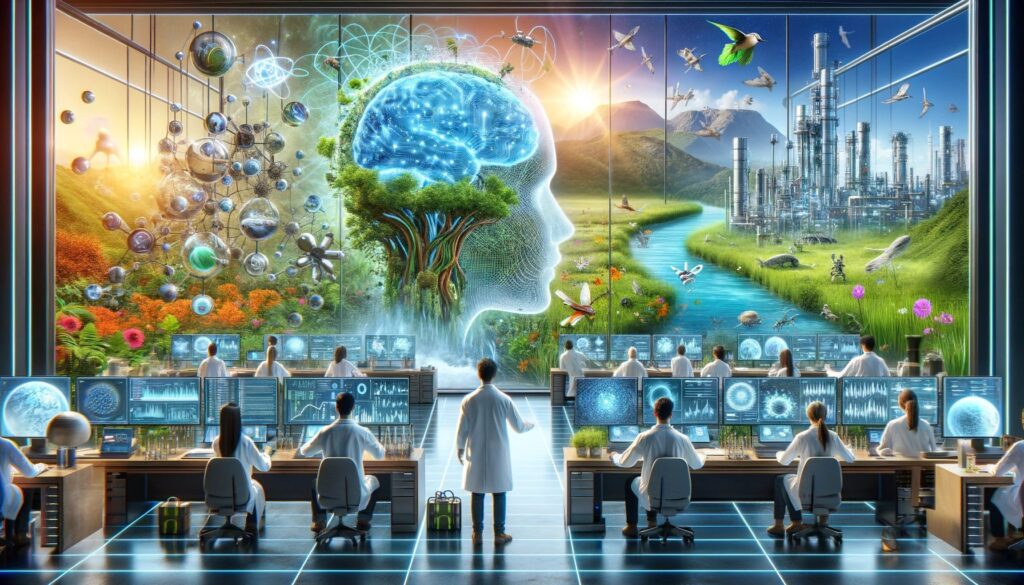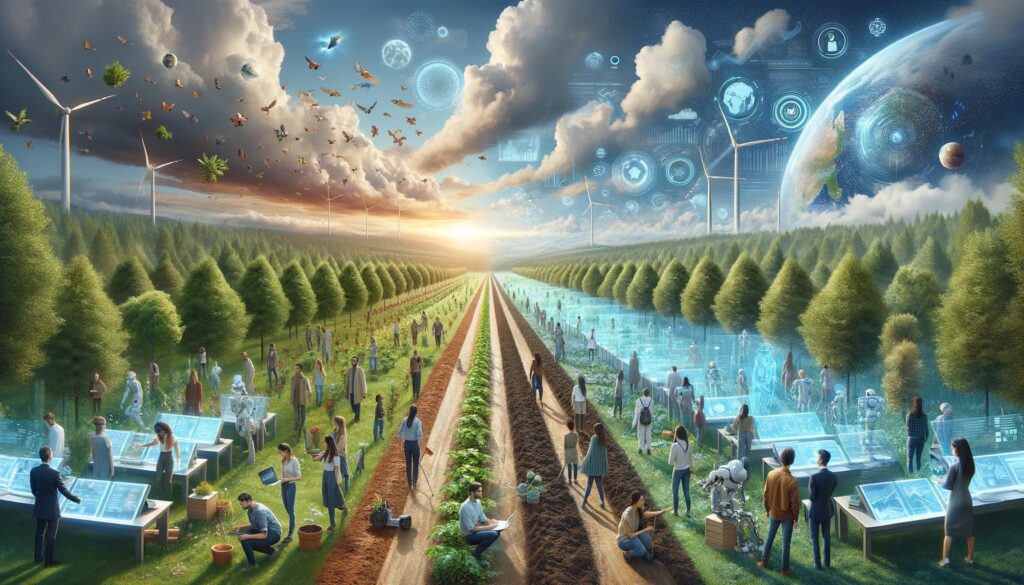In the ever-evolving landscape of technological innovation, Generative Artificial Intelligence (AI) stands as a beacon of transformative potential, particularly in the realm of environmental health research. This introduction seeks to unfold the layers of Generative AI and its profound implications in addressing some of the most pressing global environmental challenges.
Generative AI is a subset of artificial intelligence that creates fresh content, ideas, or data using learned patterns and information. It utilizes advanced algorithms like machine learning (ML) and deep learning (DL) to learn from extensive datasets, imitating human creativity. Neural networks, a key technology within Generative AI, mimic the human brain’s structure and function. They analyze data, recognize patterns, and generate predictions or novel outputs, forming the foundation of Generative AI.
Generative AI’s Role in Environmental Health
Generative AI’s convergence with environmental health research highlights its versatility and profound impact. Environmental health research, focused on the effects of environmental factors on human health and ecosystems, benefits significantly from Generative AI.
AI-driven models simulate intricate environmental processes, forecast outcomes in diverse scenarios, and propose solutions to mitigate adverse effects. For instance, AI can analyze climate change data, predict air and water quality, and suggest innovative strategies for waste management and energy conservation.
| Application Area | Description | Example Use Cases |
| Climate Change Modeling | AI models simulate and predict climate patterns. | Predicting temperature changes, sea-level rise. |
| Air Quality Analysis | AI analyzes atmospheric data to assess air pollution levels. | Identifying pollution hotspots, forecasting AQI. |
| Water Quality Management | AI assists in monitoring and managing water resources. | Predicting contamination, optimizing treatment. |
| Ecosystem Conservation | AI helps in mapping and conserving biodiversity. | Wildlife tracking, habitat analysis. |
| Sustainable Agriculture | AI optimizes farming practices for environmental health. | Crop yield prediction, soil health assessment. |
The Synergy of Generative AI and Environmental Research
Generative AI has vast potential in environmental health research, transforming data processing and analysis with remarkable speed and scalability. This empowers the creation of precise models, improving decision-making and policy formulation. Importantly, it supplements rather than supplants human expertise. The synergy of environmental scientists’ creativity and critical thinking, combined with AI’s analytical capabilities, promises significant advancements. The integration of Generative AI signals a transformative era in environmental health research, fostering sustainable solutions and innovation.
The Essence of Human Creativity in AI Development
Human creativity remains the cornerstone of technological advancements, particularly in the realm of Artificial Intelligence (AI). It is the human element – the capacity for innovative thinking, problem-solving, and ethical consideration – that propels AI from a mere computational tool to a transformative force. This is especially true in the development of AI applications in environmental health, where human ingenuity is crucial in guiding AI towards effective and responsible solutions.
How Human Innovation Drives AI Advancements
In environmental health, AI’s effectiveness relies on human creativity. Innovators and scientists creatively craft AI algorithms to tackle intricate environmental issues. They pose vital questions driving AI research in fields like disease spread prediction and carbon emissions reduction. Human expertise remains vital in interpreting AI-generated data, translating it into actionable insights and policies. In this collaborative effort, human creativity remains central to AI’s progress in environmental health.
Illustrative Examples of Innovative AI Applications in Environmental Health
Several case studies highlight the successful integration of human creativity and AI in environmental health:
- Air Pollution Prediction: AI analyzes environmental data to predict air pollution, aiding city planners and health officials.
- Climate Change and Disease: AI links climate change and vector-borne diseases, offering insights for healthcare readiness.
- Wildlife Conservation: AI-powered drones and image recognition protect endangered species and natural habitats.
- Water Quality Innovation: AI integrates sensors and satellite data for real-time water quality monitoring.
AI’s Role in Advancing Environmental Health Research

The infusion of Artificial Intelligence (AI) into environmental health research has catalyzed a paradigm shift in how we approach and solve ecological challenges. AI’s unparalleled data processing capabilities, coupled with its predictive analytics, are driving significant advancements in this field.
Specific AI Applications in Environmental Studies
AI’s applications in environmental studies are diverse and impactful. Here are some specific ways AI is being utilized:
- Climate Change Modeling: AI models complex climate systems, offering detailed predictions of future climate scenarios and their impacts.
- Biodiversity Monitoring: AI-driven tools rapidly analyze wildlife and habitat data, aiding in monitoring species and ecosystem health.
- Pollution Management: AI identifies pollution sources, predicts air and water quality, and recommends control measures.
- Renewable Energy Enhancement: AI predicts weather and energy demand, improving the efficiency of wind and solar power generation.
Achievements and Milestones in Innovation
The deployment of AI in environmental health research has led to numerous success stories and breakthroughs:
- Forest Fire Prediction: AI analyzes weather, fire history, and vegetation data to predict and mitigate wildfires, enabling early interventions.
- Ocean Health: AI processes data from buoys, satellites, and ocean missions for improved understanding and management of marine ecosystems.
- Sustainable Urban Planning: AI-driven analytics optimize cities by analyzing traffic, energy use, and development, promoting greener urban environments.
- Agricultural Sustainability: AI tools aid precision farming, soil health monitoring, and water usage optimization, enhancing sustainable food production.
Bridging the Gap: Human-AI Collaboration
The fusion of human expertise with AI capabilities marks a new era in environmental health research. This collaboration is not just about using AI as a tool but about creating a partnership where human insights and AI’s analytical prowess work in tandem. This synergy is crucial for tackling complex environmental issues more effectively and ethically.
Integrating Human Expertise with AI Capabilities
The integration of human expertise and AI capabilities is evident in various aspects of environmental health research:
- Data Interpretation: AI processes data, but human experts provide essential context, ensuring AI insights inform decision-making.
- Algorithm Development: Human expertise guides AI model design and training, tailoring it to environmental challenges.
- Ethical Oversight: Humans ensure AI follows ethical standards in handling sensitive environmental data.
- Interdisciplinary Teams: Collaboration between ecologists, data scientists, policymakers, and communities enriches AI’s role in environmental research.
Examples of Successful Collaborations
Several successful collaborations between humans and AI have led to notable advancements in environmental health:
- Coral Reef Conservation: AI and marine biology collaboration analyzes reef images, aiding rapid health assessment for conservation.
- Smart Farming: AI and agriculture merge for data-driven crop management, soil health, and resource optimization, boosting sustainability.
- Urban Air Quality: Environmental scientists, data analysts, and AI experts create predictive models for pollution reduction and public health improvement.
- Wildlife Tracking: Conservationists and AI specialists develop systems to monitor endangered species, offering vital data for conservation efforts.
Ethical Considerations and Sustainable Practices
The integration of AI into environmental health research brings with it a host of ethical considerations and the need for sustainable practices. As we embrace the power of AI, it’s crucial to navigate these challenges thoughtfully to ensure that the technology benefits both the environment and society.
Addressing Ethical Dilemmas in AI Usage
The use of AI in environmental research must be guided by a strong ethical framework to prevent misuse and unintended consequences. This includes ensuring data privacy, avoiding biases in AI models, and maintaining transparency in AI operations. Environmental researchers and AI developers must work together to identify potential ethical issues and develop guidelines that ensure AI is used responsibly, respecting both environmental and human rights.
Promoting Sustainable AI Development in Environmental Research
Sustainable development of AI in environmental research involves minimizing the ecological footprint of AI systems themselves. This includes optimizing the energy efficiency of data centers that power AI computations and choosing environmentally friendly practices in the entire lifecycle of AI development. Furthermore, sustainability in AI also means focusing on long-term solutions that can adapt to changing environmental conditions and societal needs, ensuring that AI applications remain relevant and beneficial for future generations.
Emerging Horizons: The Synergy of AI and Human Ingenuity in Environmental Well-being

As we look towards the future, the convergence of AI and human creativity in environmental health research is poised to unleash unprecedented possibilities. This evolving landscape promises to reshape how we understand and interact with our environment.
Predictions for Future Developments
The advancements in AI and its integration with human creativity are expected to lead to more sophisticated and effective environmental solutions. We anticipate AI systems that can predict environmental changes with greater accuracy and speed, offering vital insights for proactive measures. Innovations in AI are also likely to lead to more personalized and community-centric environmental health initiatives, where AI tools can be tailored to address specific local environmental challenges.
Potential Challenges and Opportunities
Challenges:
- Data Privacy and Security: As AI systems handle more sensitive environmental data, ensuring privacy and security becomes increasingly crucial.
- Ethical and Regulatory Compliance: Balancing technological innovation with ethical considerations and regulatory standards will be a continuing challenge.
- Technological Accessibility: Ensuring equitable access to AI technologies across different regions and communities remains a significant concern.
Opportunities:
- Enhanced Environmental Monitoring: AI can offer more comprehensive and real-time monitoring of environmental changes and threats.
- Collaborative Problem-Solving: The fusion of AI with diverse human expertise can lead to more innovative and effective environmental solutions.
- Education and Awareness: AI can play a key role in environmental education, raising awareness and engagement through interactive and personalized learning experiences.
Conclusion: The Indispensable Role of Human Creativity
AI’s integration in environmental health research underscores human creativity’s significance. Our innovative thinking, data interpretation, and ethical considerations unlock AI’s potential. This synergy enhances our ability to tackle environmental challenges while envisioning technology and nature coexisting harmoniously. As AI becomes integral in our efforts, this blend of human creativity and artificial intelligence guides us toward a more sustainable and healthier planet. In this intricate tapestry of environmental health research, AI is a potent thread, woven with human insight and ingenuity. By maintaining a balanced, ethical, and collaborative approach, the fusion of AI with human creativity promises innovative solutions to present and future environmental challenges.




